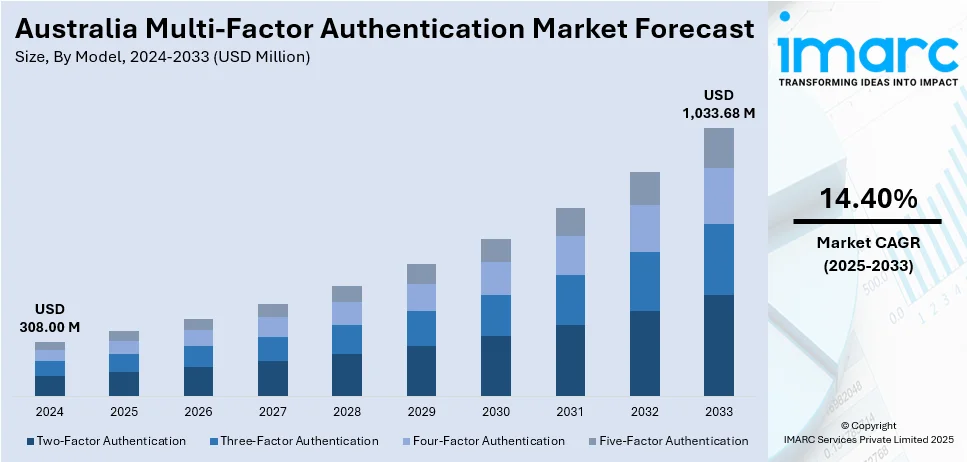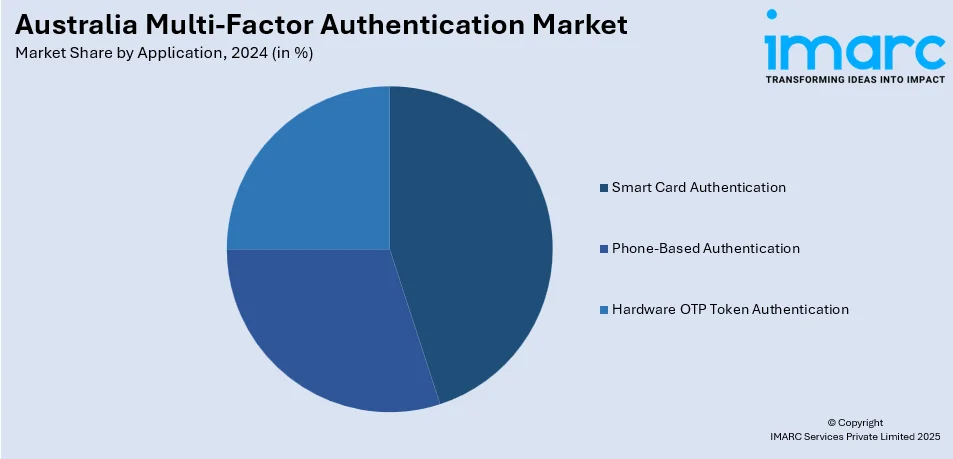
Australia Multi-Factor Authentication Market Size, Share, Trends and Forecast by Model, Deployment Type, Application, Vertical, and Region, 2025-2033
Australia Multi-Factor Authentication Market Overview:
The Australia multi-factor authentication market size reached USD 308.00 Million in 2024. Looking forward, IMARC Group expects the market to reach USD 1,033.68 Million by 2033, exhibiting a growth rate (CAGR) of 14.40% during 2025-2033. The market is experiencing a significant growth due to the rising incidence of cyber-attacks, higher demand for cloud services, and increasing awareness regarding data protection. Compliance with regulatory requirements in industries like finance, healthcare, and government also compels organizations to implement multi-factor authentication solutions. Moreover, the transition to hybrid and remote working models has intensified the requirement for secure access control, further fueling the Australia multi-factor authentication market share.
|
Report Attribute
|
Key Statistics
|
|---|---|
|
Base Year
|
2024 |
|
Forecast Years
|
2025-2033
|
|
Historical Years
|
2019-2024
|
| Market Size in 2024 | USD 308.00 Million |
| Market Forecast in 2033 | USD 1,033.68 Million |
| Market Growth Rate 2025-2033 | 14.40% |
Australia Multi-Factor Authentication Market Trends:
MFA Adoption Boom in Australian Industries
Cyber-attacks and regulatory compliance have increased the need for stringent security across industries, causing an incredible expansion in the development of the multi-factor authentication (MFA) market in Australia. Banks, health care, and telecommunications are the industries driving the adoption of MFA for enhancing the security and confidentiality of sensitive information. The introduction of services and infrastructure that operate online, has further increased demand for strong authentication mechanisms. Multi-factor authentication is needed to help organizations reduce risks due to unauthorized access or data breaches. Hence, viable evidence of a broad focus on cybersecurity and compliance with national and international standards is to ensure that such Australian businesses are secure against emerging cyber threats.

To get more information on this market, Request Sample
Integration of Advanced Authentication Technologies
The Australia multi-factor authentication market growth is fueled by the convergence of advanced authentication technologies, such as biometric authentication and adaptive authentication. Biometric technologies, including fingerprint and facial recognition, are becoming increasingly popular due to their convenience and added security. Adaptive authentication takes advantage of contextual data, such as user behavior and device properties, to evaluate the risk level of access attempts in real-time. These technologies allow organizations to apply more sophisticated security measures, striking a balance between user experience and strong protection. Implementation of such cutting-edge solutions reflects Australia's proactive attitude towards cybersecurity in order to remain proactive in the face of evolving threats and protect digital infrastructures effectively.
Regulatory Pressures and Compliance Drivers
Regulatory authorities in Australia increasingly require the adoption of MFA to maintain data security and privacy. Compliance with regulations like the Australian Privacy Principles (APPs) and industry-specific rules requires adopting secure authentication processes. Organizations are being forced to implement MFA solutions in order to satisfy these regulatory requirements and prevent potential fines. This regulatory push is hastening the adoption of MFA in multiple industries, emphasizing the need for secure access controls to ensure trust and compliance. With cyber threats continually evolving, regulatory agencies will be forced to make more stringent regulations, further fueling the MFA market in Australia.
Australia Multi-Factor Authentication Market Segmentation:
IMARC Group provides an analysis of the key trends in each segment of the market, along with forecasts at the country and regional levels for 2025-2033. Our report has categorized the market based on model, deployment type, application, and vertical.
Model Insights:
- Two-Factor Authentication
- Three-Factor Authentication
- Four-Factor Authentication
- Five-Factor Authentication
The report has provided a detailed breakup and analysis of the market based on the model. This includes two-factor authentication, three-factor authentication, four-factor authentication, and five-factor authentication.
Deployment Type Insights:
- On-Premises
- On-Cloud
The report has provided a detailed breakup and analysis of the market based on the deployment type. This includes on-premises and on-cloud.
Application Insights:

- Smart Card Authentication
- Phone-Based Authentication
- Hardware OTP Token Authentication
The report has provided a detailed breakup and analysis of the market based on the application. This includes smart card authentication, phone-based authentication, and hardware OTP token authentication.
Vertical Insights:
- Banking and Finance
- Government
- Travel and Immigration
- Military and Defense
- IT and Telecom
- Healthcare
- Retail and Ecommerce
- Others
The report has provided a detailed breakup and analysis of the market based on the vertical. This includes banking and finance, government, travel and immigration, military and defense, IT and telecom, healthcare, retail and ecommerce, and others.
Regional Insights:
- Australia Capital Territory & New South Wales
- Victoria & Tasmania
- Queensland
- Northern Territory & Southern Australia
- Western Australia
The report has also provided a comprehensive analysis of all the major regional markets, which include Australia Capital Territory & New South Wales, Victoria & Tasmania, Queensland, Northern Territory & Southern Australia, and Western Australia.
Competitive Landscape:
The market research report has also provided a comprehensive analysis of the competitive landscape. Competitive analysis such as market structure, key player positioning, top winning strategies, competitive dashboard, and company evaluation quadrant has been covered in the report. Also, detailed profiles of all major companies have been provided.
Australia Multi-Factor Authentication Market News:
- On April 10, 2025, AustralianSuper accelerated efforts to implement broader multi-factor authentication (MFA) measures following a cyberattack that led to the loss of $500,000 from member accounts. Last week, Australia’s multi-trillion-dollar superannuation sector suffered a large-scale cyberattack aimed at customer accounts.
- In June 2024, The Queensland Digital Licence App exceeded 500,000 users since its launch on November 1, 2023, demonstrating significant enthusiasm among consumers for a secure and trustworthy digital identity. Thales, alongside the Queensland Department of Transport and Main Roads (TMR), introduced the new app for all the residents of Queensland following a successful pilot and a lengthy trial in Townsville, where engagement with real end users, businesses, and industry groups provided essential insights for the project ahead of the launch. The app provides features such as integration with the Queensland Digital Identity (QDI) service, multi-factor authentication, and an internal verification system to facilitate secure information sharing among users.
Australia Multi-Factor Authentication Market Report Coverage:
| Report Features | Details |
|---|---|
| Base Year of the Analysis | 2024 |
| Historical Period | 2019-2024 |
| Forecast Period | 2025-2033 |
| Units | Million USD |
| Scope of the Report | Exploration of Historical Trends and Market Outlook, Industry Catalysts and Challenges, Segment-Wise Historical and Future Market Assessment:
|
| Models Covered | Two-Factor Authentication, Three-Factor Authentication, Four-Factor Authentication, Five-Factor Authentication |
| Deployment Types Covered | On-Premises, On-Cloud |
| Applications Covered | Smart Card Authentication, Phone-Based Authentication, Hardware OTP Token Authentication |
| Verticals Covered | Banking and Finance, Government, Travel and Immigration, Military and Defense, IT and Telecom, Healthcare, Retail and Ecommerce, Others |
| Regions Covered | Australia Capital Territory & New South Wales, Victoria & Tasmania, Queensland, Northern Territory & Southern Australia, Western Australia |
| Customization Scope | 10% Free Customization |
| Post-Sale Analyst Support | 10-12 Weeks |
| Delivery Format | PDF and Excel through Email (We can also provide the editable version of the report in PPT/Word format on special request) |
Key Questions Answered in This Report:
- How has the Australia multi-factor authentication market performed so far and how will it perform in the coming years?
- What is the breakup of the Australia multi-factor authentication market on the basis of model?
- What is the breakup of the Australia multi-factor authentication market on the basis of deployment type?
- What is the breakup of the Australia multi-factor authentication market on the basis of application?
- What is the breakup of the Australia multi-factor authentication market on the basis of vertical?
- What is the breakup of the Australia multi-factor authentication market on the basis of region?
- What are the various stages in the value chain of the Australia multi-factor authentication market?
- What are the key driving factors and challenges in the Australia multi-factor authentication market?
- What is the structure of the Australia multi-factor authentication market and who are the key players?
- What is the degree of competition in the Australia multi-factor authentication market?
Key Benefits for Stakeholders:
- IMARC’s industry report offers a comprehensive quantitative analysis of various market segments, historical and current market trends, market forecasts, and dynamics of the Australia multi-factor authentication market from 2019-2033.
- The research report provides the latest information on the market drivers, challenges, and opportunities in the Australia multi-factor authentication market.
- Porter's five forces analysis assist stakeholders in assessing the impact of new entrants, competitive rivalry, supplier power, buyer power, and the threat of substitution. It helps stakeholders to analyze the level of competition within the Australia multi-factor authentication industry and its attractiveness.
- Competitive landscape allows stakeholders to understand their competitive environment and provides an insight into the current positions of key players in the market.
Need more help?
- Speak to our experienced analysts for insights on the current market scenarios.
- Include additional segments and countries to customize the report as per your requirement.
- Gain an unparalleled competitive advantage in your domain by understanding how to utilize the report and positively impacting your operations and revenue.
- For further assistance, please connect with our analysts.
 Request Customization
Request Customization
 Speak to an Analyst
Speak to an Analyst
 Request Brochure
Request Brochure
 Inquire Before Buying
Inquire Before Buying




.webp)




.webp)












